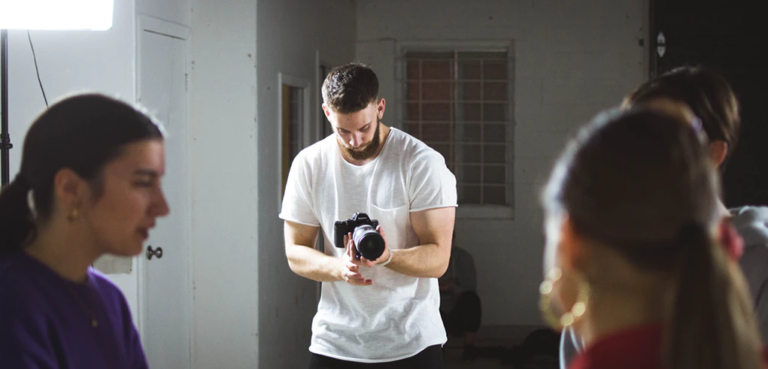[Guest Post: Sam Shepler]
Think about the last time you wanted to buy something on the web. Chances are, you spent hours scouring the internet for people’s reviews on the products you want to buy. But, let’s say there were no reviews. This could put a damper on your purchase as no one likes to buy something without knowing what previous buyers thought about it.
Suppose your brand is in this category where your products have little to no reviews, or the ones left by the customers are not as captivating. Then, it is time to implement a strategy that will bring more customers to your website and increase sales.
You can start by creating B2B video testimonials strategies on your website. Using video reviews brings a human touch to your products as customers can relate to the person reviewing the products. We are in an era where everything is digital and from the look of things, video testimonials dominate the business world, so why not give video testimonials a try.
You may get the impression that taking a video and posting it is easy. But that’s not the case, as a lot goes into making powerful and engaging video testimonials. Let us explain what B2B video testimonials marketing is and why you should use it.
A customer video testimonial is a video that shows your customers speaking honestly about their experience using your products and services.
So, what are the benefits of having video testimonials in your business?
- It helps show customers that your brand is credible and trustworthy
- The customer helps explain how to use the products, benefits, and experience, which can appeal to your target customers.
- Improves conversion rate
- It is natural and user-friendly. It is easier to believe a person than an ad.

Here are eight tips to use when making B2B video testimonials. First, before filming, find the right customers, those who wholeheartedly love your products.
1. Do Not Use a Script
Customers rely on video testimonials because they are authentic, so when you post a scripted video review, your customers and potential clients will know. This might make it hard for them to trust your brand.
Do not push the person making the video to speak the way you want as it might stress them and make them nervous. You can view some video testimonial examples to give you an idea of what other businesses are doing.
2. Humanize the Video with Real Emotions
The best B2B video testimonial is when your customers tell a personal and emotional story on how your products and services impacted their lives. It’s best to start with an issue that had plagued their lives, but became history after using your products. Then, you can use these video testimonial examples as your inspiration.
3. Keep it brief
Keep your video testimonial short and to the point. Nobody likes to listen to someone speaking about something for hours. A brief video will capture the attention of your viewers while getting out your message across.
Therefore, ensure that your video is about 3 minutes long or less. In addition, it would be best to caption your customer’s name and experience on the video to increase the time they spend talking about the product’s benefits.
4. Tell a Story
Present the testimonial in the form of a story. Try and make the story interesting for the listener irrespective of the interviewee’s age. To make the story authentic, write the questions following a particular order.
For example, you can start by asking what problem they were facing. How did they find out about your products? How did your products help them solve their problem?
The way they communicate the answers will create a narrative that is relatable to everyone watching.
5. Keep it Simple
Do not complicate your video testimonial by using complex terms. Use simple language and words that are understandable to your target market. You can incorporate data and statistics in your testimonial, but keep it short.
6. Send Out Questions Before the Interview
Make sure to provide your interviewee/customer with the questions before the scheduled interview. This allows them to familiarize themselves with the questions and avoid any awkward moments during the filming.
This does not necessarily mean that they need to memorize the answers for the recording. Instead, it gives them an idea of what to expect, be present, and humanize their responses.
7. Make it interesting
Don’t just set the camera only to capture the speaker’s face; it would be interesting to show his/her face at different angles, enhancing their expressions by zooming in and zooming out. This will help viewers get a perspective of the speaker’s emotions.
However, it is not a must since it requires several cameras to achieve this and a large crew, which would be expensive. That’s why it might be best to outsource the task to specialists for remote video testimonials to get the best outcome.
8. Don’t Interrupt
When filming, do not interrupt the speaker because it might appear scripted. Let them go with the flow when filming. Before posting, edit the video to remove the parts you feel are unnecessary. So no matter what the situation is, do not interrupt.
Suppose you are a small business and do not have the resources to film or hire a video testimonial service. You can request your loyal customers to send videos of themselves talking about your products or services, then ask for permission to post them on your website.
Ensure to end your video with a call to action and ask your viewers to share their experiences in the comment section.
Now let us see how to boost sales using video testimonials.
How to use B2B video testimonial in marketing to drive sales
After creating a powerful customer testimonial video, you must position it in a manner that is going to boost sales. For example, a survey conducted in December 2020 shows that 84% of consumers are more likely to buy a product after watching the brand’s video.
In addition, the survey found out that after three days, people remember about 10% of what they heard but still retain about 65% of the images in the video. This clearly shows that B2B video testimonials are a powerful marketing strategy for any business looking to boost sales.
Where should you use the B2B testimonial videos?
Landing Page
This is the first place your customer lands upon visiting your website. Statistics show that landing pages/ homepages increase the conversion rate by 86%. Customer testimonial videos help to:
- Generate leads
- Persuade prospective client to buy your products
You can also add a testimonial page on your website where clients can go to see other customer reviews.
Social Media
Almost everyone, from teens to baby boomers, is on social media. So why not post your customer testimonial video on social media where you will have a broader reach? From small enterprises to large corporations, you will find they are all present on social media.
A Digital 2020 report, published in collaboration with We Are Social and Hootsuite, shows that digital, mobile, and social media are indispensable parts of our daily lives worldwide. Over 4.5 billion people are using the internet as of Jan 1st, 2020, while social media users are above 3.8 billion. These are all potential customers you can target.
Make a habit of posting customer video testimonials on your social media pages to increase brand awareness and drive targeted traffic to your website. You can also run a campaign on your social media pages.
Analyze your testimonials

Since the video does not provide in-depth information, make an individual case study for the client by explaining how the customer used the products to the final results. This makes it easier for your customers and prospects to follow.
For instance, many people are advertising their nutrition programs by showing their clients’ before and after pictures. While this is encouraging, it doesn’t show you the whole process or how long it took. So a case study would be best at this strategy as it would explain their nutrition and exercise in detail.
After creating the video and publishing it on multiple channels, automate some tasks, such as data entry and sales tracking. Automation will improve your team’s productivity by approximately 46%. This is because it eliminates the data entry tasks since it logs every potential interaction in real-time.
In addition, the Sales tracking feature provides you with clear insights and analytics, which show you whether your video strategy is working.
Final Thoughts
Scaling a business is easy if you know what you are doing. The way you use customer reviews to promote sales plays a crucial role in your business. As we’ve seen, B2B video testimonials are here to stay, so don’t get left behind. Get creative and start posting.
Also, be ready to tweak the videos as each channel is different from the other. Don’t give up because the first video does not convert as per your predictions. Everything takes work and time. Doing it consistently will lead to better results.
About the Author

Sam Shepler is the founder and CEO of Testimonial Hero. 150+ B2B revenue teams at Google, UiPath, Medallia, InsightSquared, and many others use Testimonial Hero to easily create customer videos that engage prospects, reduce friction in the sales cycle, and drive more revenue faster. Twitter | LinkedIn



